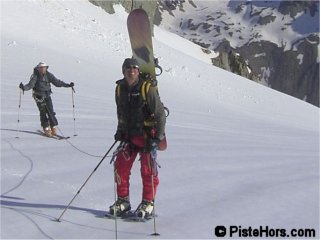
Technique > Glacier Travel for Skiers and Snowboarders > Roping Up
When climbing on any snow-covered glaciated terrain members of the group should rope together and carry equipment for crevasse rescue. Do this even if the route is well trodden, your passage may just be the one that breaks the snow-bridge's back. It is normally, but not always, the first member of the group that will have the nasty surprise of discovering a poorly bridged glacier. It is therefore prudent for the more experienced member to bring up the rear. That way they will be on the surface to help with the rescue.
Descending rope-up may be necessary on the most dangerous terrain but because the skier is moving faster less pressure is applied to snow bridges. Skiing while roped to another person is not fun and a mix of skiers and snowboarders with their different techniques is even less amusing. You may chose to let the lightest member go first as the heavier members will stand more chance of holding his weight uphill of the crevasse.

Rope up when climbing glaciers
Ideally groups should number 3 or above, that way there will, hopefully, be two people left on the surface to help anyone who tumbles into a crevasse. About 9 meters gap should be left between each skier. So the common 25 meter randonnée rope can take 3 to 4 skiers. Two tying to either end and the other making a figure of 8 in the middle and clipping to his harness with a caribiner. If their is spare rope this can be taken up by coiling the extra length. Too long a spacing will mean further to fall and a greater shock for those skiers left on the surface. There is some debate as to whether to take coils over or under the rucksack. Under the rucksack means the the pack can be taken off easily, say to read food or other equipment. However it may prove uncomfortable and the rucksack must be removed if adjusting the number of coils. Don't carry coils in your hand, the shock of the fall will whip them away and give the victim a second, nasty jolt and may break the holder's fingers. As you can see in the photo, the rope should be kept reasonably tight at all times. This takes some discipline, especially when mixing skiers and snowboarders or people of different fitness and ability. Move at the pace of the slowest.
A couple of prussik loops can be added to the rope close to where it is attached to the harness. These will be ready for any rescue effort.
<< Glacier Gear | Glacier Travel for Skiers and Snowboarders | Crevasse Rescue >>